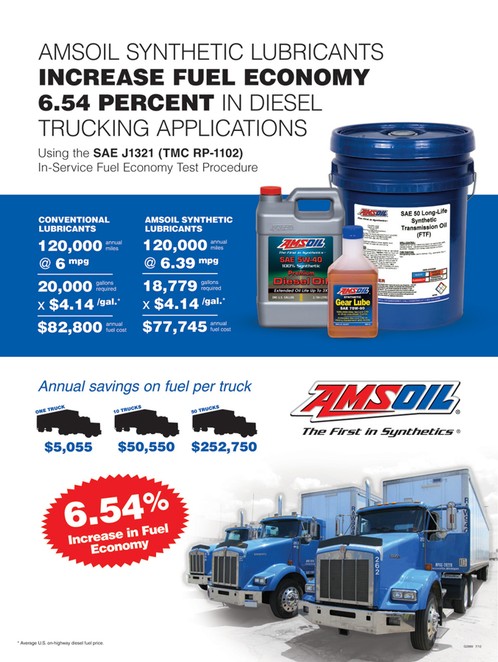Engine Oil Evaluation Tests - Select Synthetics - AMSOIL Authorized Dealer



Main menu:
- Home Page
-
Products
-
AMSOIL Products
- Shop by Product
- Shop by Equipment
- Shop by Category
-
Product Lookup Guides
- Product Lookup Guides - Home
- Filter Lookup Guides
- Auto & Light Truck Lookup Guide
- Motorcycle & Dirt Bike Lookup Guide
- Harley-Davidson Products Guide
- All-Terrain Vehicle Lookup Guide
- Utility Terrain Vehicle Lookup Guide
- Snowmobile Lookup Guide
- Marine Outboard Lookup Guide
- Personal Watercraft Lookup Guide
- Small Engine Lookup Guide
- Free Product Catalog
- AMSOIL - The Blog
- AMSOIL YouTube Videos
- AMSOIL Performance Tests
- The AMSOIL Newsstand
- AMSOIL Testimonials
- AMSOIL Guarantee
- Safety Data Sheets
- Oil Analysis Services
- Shipping & Product Return
- Safe & Secure Shopping
-
AMSOIL Products
- About AMSOIL
-
Oil Basics
- What Is Motor Oil?
- What Is Oil Viscosity?
- What Does Motor Oil Do?
- Why Does Oil Need To Be Changed?
- How Often Should I Change My Oil?
- When Should I Do My 1st Oil Change?
- Can I Mix Different Oils?
- Lubrication Regimes
- Newtonian vs. Non-Newtonian
- Base Oil Groups
- Motor Oil Specifications
- Service Classifications & Grades
- Oil Evaluation Tests
- Oil Filtration
- What is Oil Analysis?
- Why Synthetics?
- Buy Wholesale
- FAQs
- Contact Us
Oil Basics


Oil Evaluation Tests
ASTM – Measures That Matter
The American Society for Testing and Materials (ASTM) recognized the need for uniform procedures that can be duplicated and verified by laboratories in any location. The official publication of ASTM International is called Standardization News.
Founded in 1898 and completely voluntary, ASTM is now one of the largest non-profit standards development systems in the world. The organization currently has 134 committees that write standardised test methods for materials, products, systems and services.
More than 8500 ASTM specifications have been established for products as diverse as metal, paint, plastics, textiles, energy, consumer products, medical services and instruments, and the environment. Developing standard measurement methods is part of the task of ASTM.
What follows here are a few of the tests commonly used to evaluate motor oil performance.
ASTM D-445 - Kinematic Viscosity
Kinematic Viscosity is the amount of time, in centistokes (mm2/s), that it takes for a specified volume of fluid to flow, under the force of gravity, through a fixed diameter orifice at a given temperature. Since kinematic viscosity varies inversely with temperature, its value is meaningless unless the temperature at which it is determined is given.
Kinematic viscosity is determined by using a Capillary Tube Viscometer.
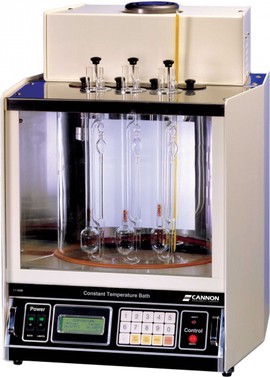
The kinematic viscosity is calculated by multiplying the measured flow time by the calibration constant for that viscometer and is then reported in centistokes at a given temperature (usually 100°C and 40°C).
The proper operation of equipment depends on the proper kinematic viscosity of the oil at operating temperatures (usually around 100°C).
ASTM D-2270 - Viscosity Index
The Viscosity Index (VI) is an arbitrary measure of the variation in the kinematic viscosity of oil due to changes in temperature between 40°C and 100°C. For example, a higher viscosity index indicates that the kinematic viscosity of the lubricant will decrease very little when the temperature is increased.
The VI is simply reported as a numerical value that has no units. A high Viscosity Index is desirable. The higher the viscosity index the better the motor oils will perform in temperature extremes.
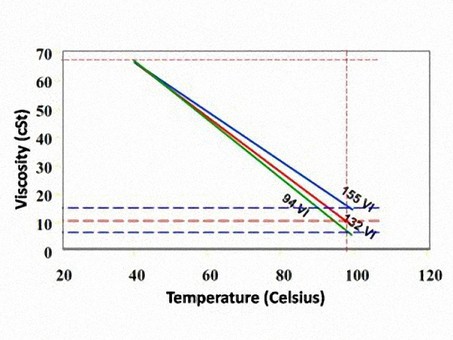
ASTM D-3829 - Borderline Pumping Temperature (BPT)
The Borderline Pumping Temperature Test (BPT) measures the lowest temperature at which an oil can be continuously and adequately supplied to the oil pump inlet of an engine. As the name suggests, the lower the number, the better the oil circulates in cold weather.
Cold Pumping viscosity is usually determined by using a Mini Rotary Viscometer (MRV).
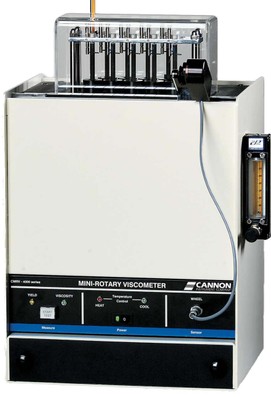
This test covers the prediction of the borderline pumping temperature (BPT) of engine oils through the use of a 16 h cooling cycle over the temperature range from 0 °C to −40 °C. The precision is stated for temps from –34 °C to –15 °C.
Synthetic oils are famed for their extremely low temperature pumpability and protection.
ASTM D-4172B - Four Ball Wear Test
The Four Ball Wear Test can be used to determine the relative wear preventive properties of lubricating fluids in sliding contact under the prescribed test conditions.
The test involves three fixed balls in a bath of lubricant with a fourth ball in rolling contact under pressure at a specific level of severity.
Wear protection is gauged by measuring the wear scar that develops. A smaller wear scar means better protection in typical engine operations.
AMSOIL Synthetic Oils consistently outperform the competition in the Four Ball Wear Test.
ASTM D-4683 – High-Temperature High-Shear (HTHS) Viscosity
Viscosity at the shear rate and temperature of this High-temperature High-shear test method is thought to be representative of the condition encountered in certain areas of an engine when operating under load in severe service conditions.
In this method, the viscosity of fluid is measured using a High-Temperature High-Shear Capillary Viscometer.
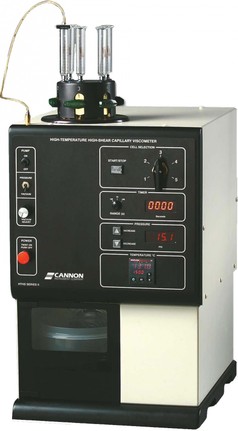
This viscometer uses a closely fitted rotor inside a matched stator to subject the fluid to a 1X106 s-1 shear rate at 150°C.
The rotor exhibits a reactive torque response when it encounters resistance from oil that fills the area between the rotor and the stator. This torque is measured and compared to calibration oils with known torque values to determine the viscosity of the test oil. The resulting viscosity is then reported in units of centipoise (cP).
Lubricants with high scores, such as AMSOIL’s products, maintain their viscosity in high temperatures after exposure to high shear. This means that they continue to protect bearings even after exposure to severe service conditions.
ASTM D-4684 – Yield Stress and Apparent Viscosity at Low Temperature
When a fluid is cooled, the rate and duration of cooling may affect the oil’s yield stress and apparent viscosity.
In this test method, oil is cooled slowly through a temperature range in which wax crystallization is known to occur, followed by rapid cooling to the final test temperature.
The Cold Pumpability test is always conducted at 5°C colder than the Cold Cranking test to ensure the pump can deliver the oil to the bearings.
Cold Pumping viscosity is determined by using a Mini Rotary Viscometer (MRV).
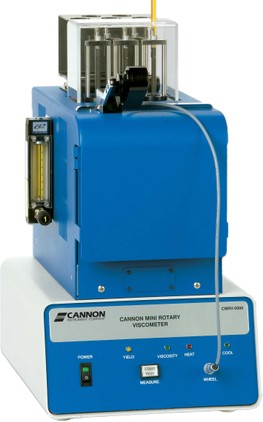
In this test, test fluid is placed in the cells of the Mini Rotary Viscometer, held at 80°C for a short time, then cooled at a programmed cooling rate over a period exceeding 45 hours to a final test temperature between -15°C and -35°C. A low torque is applied to a rotor shaft to measure the yield stress. A higher torque is then applied to determine the apparent viscosity of the sample oil.
Correlations have been found between lack of pumpability in real field applications and failures in this test. These failures in the field are thought to be the result of the oil forming a gel structure that results in excessive yield stress or viscosity of the engine oil, or both.
The low temperature viscosity is reported in the standard unit of millipascal-second (mPa-s) but may also be reported in units of centipoise (cP), which is numerically equal to mPa-s.
ASTM D-5293 - Cold Cranking Simulator - Apparent Viscosity
Cold Cranking (Apparent) Viscosity affects the startability of engines in cold temperatures. Low cold cranking viscosities make for easier cold cranking and more dependable cold temperature starting, and less drain on batteries.
The apparent viscosity of automotive oils at low temperatures is measured using the Cold-Cranking Simulator (CCS). As the name would suggest, results from this test have been correlated with low-temperature engine cranking field data.
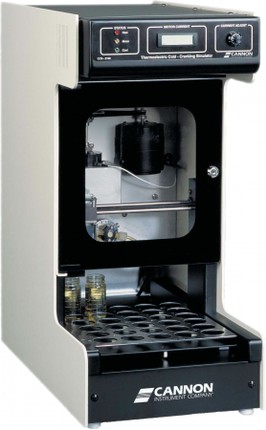
In this test method, an electric motor drives a rotor that is closely fitted inside a stator. The space between the rotor and the stator is filled with oil. The test temperature, in the range of -5°C to -30°C, is measured near the stator inner wall and maintained by regulated flow of refrigerated coolant through the stator.
The speed of the rotor is calibrated as a function of viscosity, and the test oil viscosity is determined from this calibration and the measured rotor speed. The resulting viscosity is reported in units of millipascal-second (mPa-s) or centipoise (cP), which is numerically equal to mPa-s.
ASTM D-5800 - Noack Volatility Test
The Noack Volatility Test determines the evaporation loss of lubricants in high-temperature service.
Evaporation may contribute to oil consumption in an engine and can lead to a change in the properties of an oil. The more motor oil vaporizes, the thicker and heavier it becomes, contributing to poor circulation, sludge formation, reduced fuel economy, increased oil consumption, wear, and emissions.
Many engine manufacturers specify a maximum allowable evaporation loss. Some engine manufacturers, when specifying a maximum allowable evaporation loss, quote this test method along with the specifications.
This test method covers three procedures for determining the evaporation loss of lubricating oils (particularly engine oils). Procedure A uses the Noack evaporative tester equipment; Procedure B uses the automated non-Woods metal Noack evaporative apparatus; and Procedure C uses Selby-Noack volatility test equipment. The test method relates to one set of operating conditions but may be readily adapted to other conditions when required.
The Noack Volatility of an oil is defined as the weight loss of the oil when it is held under isothermal conditions at 250 ˚C for a period of 1 hour under a constant flow of air. This test does expose the oil to relatively high temperatures and to air and simulates or approximates the conditions in the area around the top piston rings of the engine.
ASTM D-217 - The Cone Penetration Test
The Cone Penetration Test is the standard test method for cone penetration of Lubricating Greases. It evaluates the consistency of lubricating greases over the full range of NLGI numbers from 000 to 6.
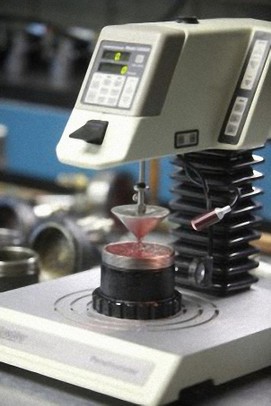
Although no correlation has been developed between cone penetration results and field service, the test is widely used for specification purposes, such as in users’ material specifications and suppliers’ manufacturing specifications.
In this test, consistency is determined by the penetration of a cone of specified dimensions, mass and finish into a standard amount of grease at 25°C. The penetration is measurement in tenths of a millimeter of how far gravity sinks the cone into the surface of the grease within 5 seconds.
The NLGI ranges are based upon conducting this measurement after subjecting grease to 60 strokes of shear in a standardized worker and then performing the cone penetration.
SAE J-1321 - Joint TMC/SAE Fuel Consumption Test Procedure
The Society of Automotive Engineers has devised a test to measure fuel consumption and fuel economy.
The Fuel Consumption Test Procedure utilizes industry accepted data collection and statistical analysis methods to determine the change in fuel consumption for trucks and buses with GVWR of more than 10,000 pounds.
The test procedure may be conducted on a test track or on a public road under controlled conditions and supported by extensive data collection and data analysis constraints. The on-road test procedure is offered as a lower cost alternative to on-track testing.
In a demonstration involving over-the-road trucks an improvement of 6.54% was achieved by switching from conventional lubes to synthetic lubricants (in this case AMSOIL) in the drive train and engine.

Home Page | Products | About AMSOIL | Oil Basics | Buy Wholesale | FAQs | Contact Us | General Site Map
